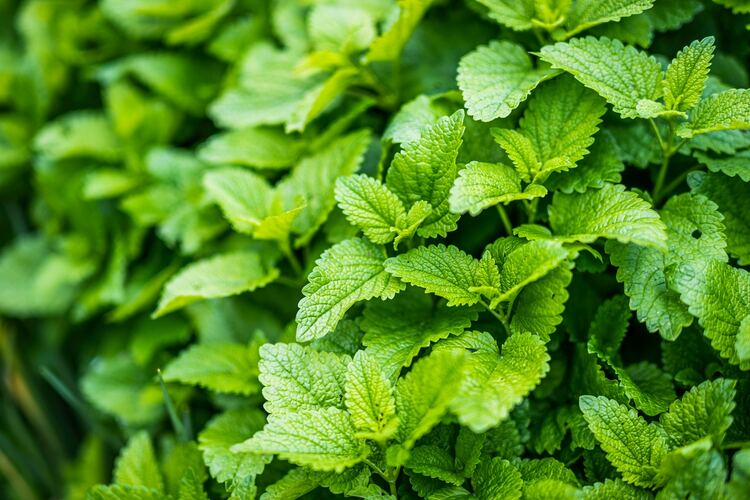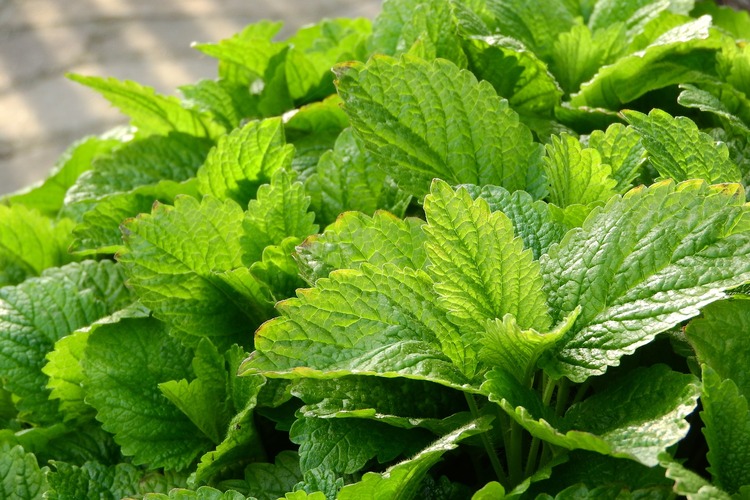What does lemon balm tea taste like? If you are thinking about a sweet and citrusy flavor, well, you are not wrong! Lemon balm is an herb that belongs to the mint family and has a distinct lemony taste and aroma. When brewed into tea, lemon balm offers a refreshing and soothing beverage that many enjoy.
The taste of lemon balm tea is often described as light, lemony, and slightly sweet. The flavor is not overpowering, making it a pleasant and easy-to-drink tea perfect for any time of day.
Keep reading to learn more about this caffeine-free alternative to traditional tea.
Please note: This article contains affiliate links, meaning I may earn a commission if you make a purchase by clicking a link. Of course, this comes at no extra cost to you and helps me keep offering readers solid information.

What is Lemon Balm Tea?
If you want a refreshing and calming tea, lemon balm tea might be the perfect choice. This herbal tea is made from the leaves of the Melissa officinalis plant, which belongs to the mint family. For the record, experts believe there are 13 to 24 existing species of mint.
History and Origins
Lemon balm has been used for centuries for its medicinal properties. The ancient Greeks and Romans believed that lemon balm had healing powers and used it to treat various ailments, including digestive problems, insomnia, and anxiety. Today, lemon balm is still valued for its calming effects and is often used in herbal medicine to alleviate stress and promote relaxation.
Growing Lemon Balm
You can grow the plant yourself if you want to make your lemon balm tea. Lemon balm is easy to grow and can be cultivated in various climates. It prefers well-drained soil and partial shade but can also tolerate full sun. You can purchase lemon balm seeds or seedlings online or at your local garden center.
Drying Lemon Balm Leaves
To make lemon balm tea, you will need to dry the leaves first. You can do this by cutting the plant’s stems and hanging them upside down in a warm, dry place. Once the leaves are dry, you can store them in an airtight container until ready to use them.
Buying Lemon Balm
Alternatively, you can buy lemon balm leaves in grocery stores, supermarkets, herb shops, farmer’s markets, or online retailers.
You may be able to find dried leaves, fresh leaves, tea bags, and even potted plants.
Also, keep in mind that choosing organic lemon balm tea can ensure that you are consuming a product free from harmful pesticides and chemicals. Organic products are more sustainable and environmentally friendly.
What Does Lemon Balm Tea Taste Like?
If you’re new to lemon balm tea, you might be curious about its taste. We are describing it in detail below.
- Citrusy: As the name suggests, lemon balm has a pronounced lemony flavor. It’s not as sharp or intense as a fresh lemon but offers a pleasant, mild citrus note.
- Sweet: Lemon balm has a subtle sweetness that balances its citrus undertones. This sweetness is often described as mildly honey-like.
- Herbaceous: Besides its citrus and sweet notes, lemon balm also has an herbaceous quality. It can be reminiscent of other herbs like mint or basil but with a lemon twist.
- Fresh and Green: Lemon balm’s fresh and green flavor makes it a refreshing addition to various dishes and beverages.
- Mild Bitterness: Some lemon balm leaves may have a hint of bitterness, but it’s generally quite mild and not overpowering.
- Floral: Lemon balm can also have a faint floral note, which adds complexity to its flavor profile.
While lemon balm tea is naturally sweet, you can add sweeteners to enhance the flavor. Honey, agave syrup, or stevia are great options if you want to add sweetness without taking over the natural flavor of the tea. Adding a splash of lemon juice can also enhance the citrusy notes of the tea.
If you want to boost the minty flavor, you can add peppermint or spearmint leaves. Both peppermint and spearmint belong to the mint plant family, so they complement the flavor of lemon balm tea nicely.

Making Lemon Balm Tea
To make lemon balm tea, you will need the following ingredients and equipment:
Ingredients
- 1 tablespoon of dried lemon balm leaves (or 2 tablespoons of fresh lemon balm leaves)
- 1 cup of boiling water
- Honey or lemon (optional, for flavor)
Equipment
- Teapot or heat-proof container with a lid
- Tea infuser or strainer
- Mug or teacup
Here’s a step-by-step guide to making lemon balm tea:
- Boil water: Start by bringing 1 cup of water to a boil. You can do this either on the stovetop or using an electric kettle.
- Prepare the lemon balm leaves: If you’re using fresh leaves, gently rinse them under running water to remove any dirt or debris. If you’re using dried leaves, you can skip this step.
- Infuse the leaves: Place the lemon balm leaves in a teapot or heat-proof container. Pour the boiling water over the leaves and cover the teapot or container with a lid. Let it steep for about 5 to 10 minutes to allow the flavors to infuse.
- Strain and serve: Use a tea infuser or strainer to separate the leaves from the liquid after steeping. Pour the tea into a mug or teacup.
- Add optional flavorings: If desired, sweeten the tea with honey or add a squeeze of lemon for extra flavor. Stir well to incorporate the flavors.
- Enjoy: Your lemon balm tea is ready to be enjoyed!

Lemon Balm Blends
If you want a refreshing tea experience, blend lemon balm with other herbs and spices. Here are a few ideas to get you started:
Lemon Balm and Mint
Lemon balm and mint are both members of the mint family, so they naturally complement each other. Brew a cup of lemon balm tea and add a few sprigs of fresh mint for a bright and refreshing flavor. You can also blend dried lemon balm and mint leaves for a more intense flavor.
Lemon Balm and Chamomile
Lemon balm and chamomile are known for their calming properties, so this blend is perfect for winding down at the end of the day. Brew a cup of lemon balm tea and add a chamomile tea bag for a soothing and relaxing experience.
Lemon Balm and Ginger
Try blending lemon balm with ginger if you want a little spice in your tea. Brew a cup of lemon balm tea and add a few slices of fresh ginger for a zesty and refreshing flavor. You can also try blending dried lemon balm and ginger root for a warming and comforting tea.
Lemon Balm and Lavender
Lemon balm and lavender have a subtle citrus flavor, making them a great pair. Brew a cup of lemon balm tea and add a few sprigs of fresh lavender for a floral and fragrant tea. You can also blend dried lemon balm and lavender flowers for a delicate and soothing tea.

Health Benefits of Lemon Balm Tea
Drinking lemon balm tea can offer several health benefits to you. Here are some of those:
- Helps in Relaxation: Lemon balm tea is known for its calming properties. It can help you relax and reduce anxiety and stress. The tea contains rosmarinic acid and eugenol, which are natural compounds that have a calming effect on the nervous system. Drinking lemon balm tea before bed can help you sleep better and wake up feeling refreshed.
- Aids in Digestion: Lemon balm tea is a natural remedy for indigestion and bloating. The tea can help stimulate digestion by increasing the production of digestive enzymes. It can also help reduce inflammation in the gut, which can lead to better gastrointestinal health.
- May Improve Cognitive Function: Studies have shown that lemon balm tea may help improve cognitive function and memory. The tea contains flavonoids that have antioxidant properties and can protect the brain from glycation-associated tissue damage, which is linked to cognitive decline.
- May Help with Menstrual Cramps: Lemon balm tea can help relieve menstrual cramps and headaches associated with menstruation. The tea contains compounds that relax the muscles, which can help reduce pain and discomfort.
- Caffeine-Free Herbal Infusion: Lemon balm tea is a caffeine-free herbal infusion, which makes it a great alternative to coffee or black tea. The tea can help you stay hydrated and alert without the side effects of caffeine.
- Antioxidant Properties: Lemon balm tea contains flavonoids that have antioxidant properties. Antioxidants can help protect your body from free radicals, which can cause cellular damage and lead to chronic diseases like diabetes and cancer.
- May Help with Nausea: Lemon balm tea can help reduce nausea and vomiting. The tea can help soothe the stomach and reduce inflammation, improving digestive health.
Top Recommendations
By now, I am sure you may be eager to try this tea (maybe you already have). We love to consume lemon balm as iced tea on hot summer days (we even prepare some and take it on camping trips). Here are our top recommendations:

Traditional Medicinals Organic Lemon Balm Herbal Tea

The Tao of Tea, Lemon Balm Herbal Tea

Celebration Herbals Organic Lemon Balm Tea Bags

I hope you have enjoyed the article and learned something new. Until next time, keep on sipping!
To you, what does lemon balm tea taste like?
More About Herbal Tea
What Does Mullein Tea Taste Like?
What Does Raspberry Leaf Tea Taste Like?
What Does Mugwort Tea Taste Like?
What Does Licorice Root Tea Taste Like?
What Does Honeybush Tea Taste Like?
What Does Mamaki Tea Taste Like?